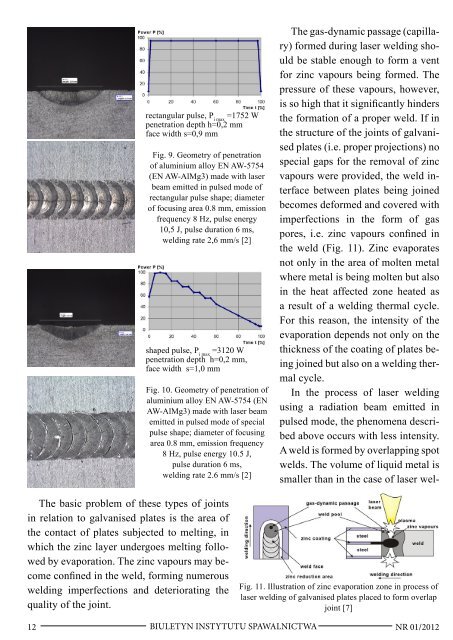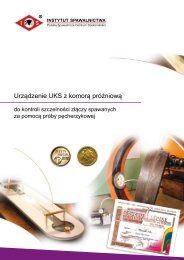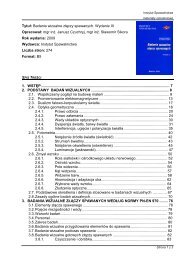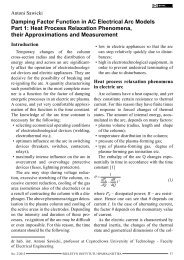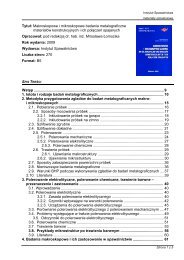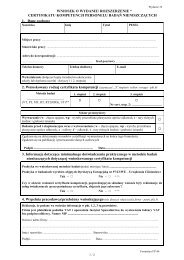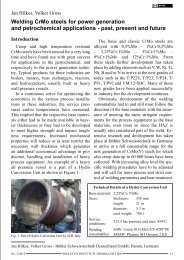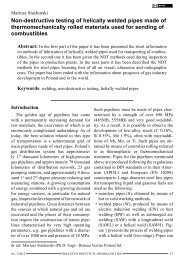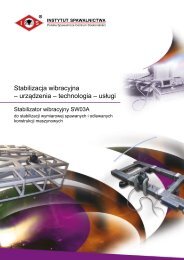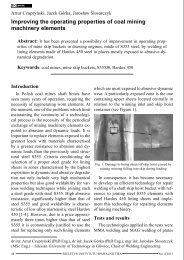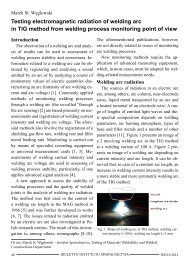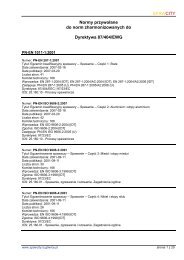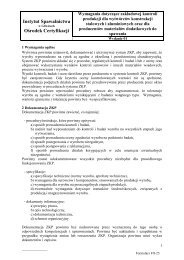Biuletyn Instytutu Spawalnictwa No. 01/2012
Biuletyn Instytutu Spawalnictwa No. 01/2012
Biuletyn Instytutu Spawalnictwa No. 01/2012
Create successful ePaper yourself
Turn your PDF publications into a flip-book with our unique Google optimized e-Paper software.
The gas-dynamic passage (capillary)<br />
formed during laser welding should<br />
be stable enough to form a vent<br />
for zinc vapours being formed. The<br />
pressure of these vapours, however,<br />
is so high that it significantly hinders<br />
the formation of a proper weld. If in<br />
the structure of the joints of galvanised<br />
plates (i.e. proper projections) no<br />
special gaps for the removal of zinc<br />
vapours were provided, the weld interface<br />
between plates being joined<br />
becomes deformed and covered with<br />
imperfections in the form of gas<br />
pores, i.e. zinc vapours confined in<br />
the weld (Fig. 11). Zinc evaporates<br />
not only in the area of molten metal<br />
where metal is being molten but also<br />
in the heat affected zone heated as<br />
a result of a welding thermal cycle.<br />
For this reason, the intensity of the<br />
evaporation depends not only on the<br />
thickness of the coating of plates being<br />
joined but also on a welding thermal<br />
cycle.<br />
In the process of laser welding<br />
using a radiation beam emitted in<br />
pulsed mode, the phenomena described<br />
above occurs with less intensity.<br />
A weld is formed by overlapping spot<br />
welds. The volume of liquid metal is<br />
smaller than in the case of laser welrectangular<br />
pulse, P i max<br />
=1752 W<br />
penetration depth h=0,2 mm<br />
face width s=0,9 mm<br />
Fig. 9. Geometry of penetration<br />
of aluminium alloy EN AW-5754<br />
(EN AW-AlMg3) made with laser<br />
beam emitted in pulsed mode of<br />
rectangular pulse shape; diameter<br />
of focusing area 0.8 mm, emission<br />
frequency 8 Hz, pulse energy<br />
10,5 J, pulse duration 6 ms,<br />
welding rate 2,6 mm/s [2]<br />
shaped pulse, P i max<br />
=3120 W<br />
penetration depth h=0,2 mm,<br />
face width s=1,0 mm<br />
Fig. 10. Geometry of penetration of<br />
aluminium alloy EN AW-5754 (EN<br />
AW-AlMg3) made with laser beam<br />
emitted in pulsed mode of special<br />
pulse shape; diameter of focusing<br />
area 0.8 mm, emission frequency<br />
8 Hz, pulse energy 10.5 J,<br />
pulse duration 6 ms,<br />
welding rate 2.6 mm/s [2]<br />
The basic problem of these types of joints<br />
in relation to galvanised plates is the area of<br />
the contact of plates subjected to melting, in<br />
which the zinc layer undergoes melting followed<br />
by evaporation. The zinc vapours may become<br />
confined in the weld, forming numerous<br />
welding imperfections and deteriorating the<br />
quality of the joint.<br />
Fig. 11. Illustration of zinc evaporation zone in process of<br />
laser welding of galvanised plates placed to form overlap<br />
joint [7]<br />
12 BIULETYN INSTYTUTU SPAWALNICTWA<br />
NR <strong>01</strong>/2<strong>01</strong>2


